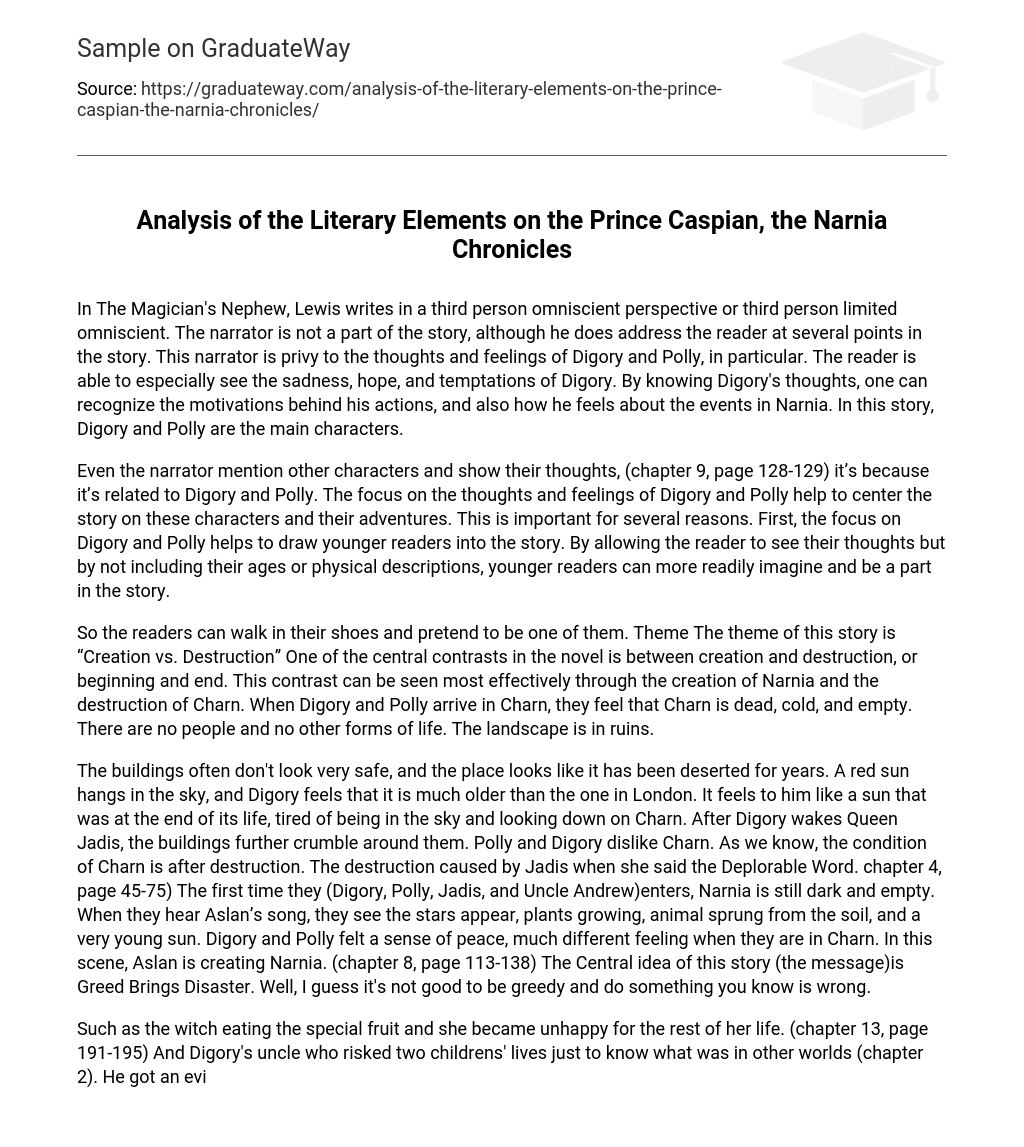In The Magician’s Nephew, Lewis employs a third person omniscient perspective or third person limited omniscient perspective. Although the narrator is not a participant in the story, they do address the reader at various points. This narrator has access to the thoughts and emotions of Digory and Polly, particularly Digory’s feelings of sadness, hope, and temptation. Through understanding Digory’s thoughts, one can comprehend his motivations and his sentiments towards the happenings in Narnia. Digory and Polly serve as the primary characters in this tale.
Even though the narrator mentions other characters and shares their thoughts in chapter 9, pages 128-129, it is because it is connected to the story of Digory and Polly. The emphasis on the thoughts and emotions of Digory and Polly serves to centralize the narrative around these characters and their exploits. This is significant for a few reasons. Firstly, focusing on Digory and Polly helps to engage younger readers in the story. By revealing their thoughts without revealing their ages or physical appearances, younger readers can easily envision themselves as part of the story.
So the readers can experience what it is like to be in their shoes and imagine themselves as one of the characters.
Theme: The central theme explored in this story is the opposition between creation and destruction. A key contrast in the novel is depicted through the creation of Narnia and the destruction of Charn. Upon arriving in Charn, Digory and Polly immediately perceive it as a lifeless, desolate place, completely devoid of people or any other living beings. The barren landscape stands as a stark testament to its ruins.
The buildings in Charn appear unsafe and abandoned for many years. The sky holds a red sun that seems much older than the one in London. It gives Digory the feeling of a tired sun at the end of its life, overseeing Charn. Once awakened by Digory, Queen Jadis, the buildings around them further crumble. Both Polly and Digory dislike Charn due to its ruined state caused by Jadis using the Deplorable Word (chapter 4, page 45-75). Upon their initial arrival in Narnia, it is still dark and empty. Only when they hear Aslan’s song do the stars emerge, plants grow, animals come to life, and a young sun shines. Digory and Polly experience a sense of peace contrasting their time in Charn. This scene depicts Aslan’s creation of Narnia (chapter 8, page 113-138). The central message of this story is that greed leads to disaster. Being greedy and committing wrongdoing is not advisable.
The text describes various instances of characters in the book engaging in curious and potentially dangerous actions. In Chapter 13, pages 191-195, there is a witch who eats a special fruit and subsequently becomes unhappy for the rest of her life. In Chapter 2, Digory’s uncle puts the lives of two children at risk in order to explore other worlds, ultimately leading to a dealing with an evil witch. One lesson that can be learned from these examples is to be cautious about curiosity. While discovering new things can be beneficial, as seen in Digory’s case with the magic bell in Chapter 4, pages 57-59, it is sometimes better to leave things alone. His actions resulted in bringing the evil witch to both his world and Narnia.
In Narnia, it is important to heed the commands of God, symbolized by Aslan. Following God’s guidance ultimately leads to positive outcomes. The author employs a straightforward writing style with simple language and concise sentences to ensure that young readers, specifically children, can easily comprehend the story. The author purposely omits detailed descriptions of Digory and Polly’s ages and physical appearances, encouraging readers to envision themselves as these characters and partake in their adventures. Similarly, minimal details are provided about Aslan because he represents God in the narrative, and one cannot fully understand the mind of God.





